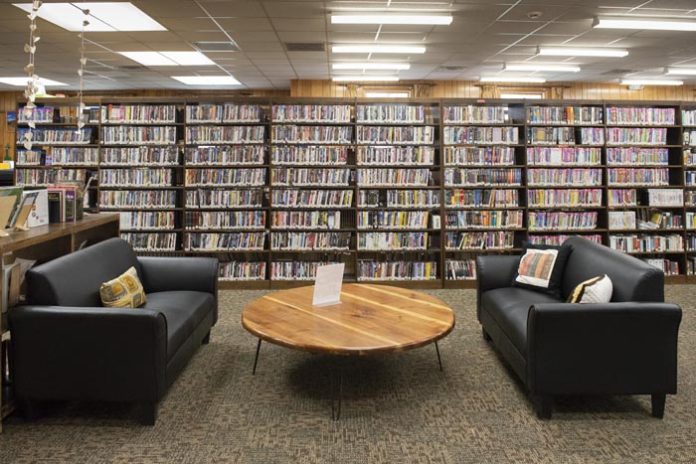Walking through the lobby, glancing up at its ornate rotunda ceiling, and entering the central room of the Adriance Memorial Library in Poughkeepsie, the first thing I noticed was the embracing hush. If you’re seeking calm, there’s nothing like the focused quiet of a library, and the Hudson Valley abounds in libraries, each one different, expressing the unique character of its city, town or hamlet.
At Adriance, I broke the silence by telling the librarian at the desk, in as quiet a voice as I could manage, that I had memories of walking down a flagstone path to the back door where the children’s books were located. “Oh yes, I remember that, too,” she nodded. The children’s room is now on the second floor, and its previous spot was incorporated into the main part of the building during one of its modernizations. Libraries change over time, and this splendid Classical Revival building has been open to the public since 1898, so it’s undergone several renovations.
As one of the largest libraries in the region, Adriance has lots of stacks to browse, an under-appreciated pleasure, I find, in the days of online search and the immensely useful “hold” system. Not that I don’t appreciate having access to over 1.3 million books available in the Mid-Hudson Library System (MHLS), but there’s nothing like touching and peeking into physical books as you search for the one you want.

Library services are changing, as we learned when the Phoenicia Library (in my present home town) was rebuilt after a devastating fire in 2010. The community so loved its library that several years of fundraising pulled together enough money to completely redesign and rebuild the structure, following guidelines based on the needs of modern patrons. When I first walked into the spanking new building, I was impressed by the environmentally sustainable materials and energy-saving heat-pump regulation, a handsome circulation desk made of warm reddish-brown wood, a bank of new computers, a separate room for Phoenicia’s unique collection of books on fly fishing, and a large, bright activity room, perfect for the programs which are more and more in demand.
But to my surprise, there were no stacks. Instead of rows of bookcases in the middle of the rooms, all the walls were neatly lined with books, leaving space for study tables and the set-up of chairs for event seating.

The modern library’s role has increasingly extended to digital and social needs. With the sophisticated hold system, it’s easy to get a book from any MHLS library. In fact, the online catalog is much easier to search than the old card catalog. With no need to jot down Dewey’s organizing decimals, you just pop in a search term, and away you go. You don’t even have to leave your house, except to pick up the book when it arrives at the library in a couple of days. The catalog includes a description of each book, so although you can’t look behind the covers, it does resemble browsing.
With this efficient book distribution system, the building itself turns to other functions. At Phoenicia, you can check out a fishing rod or a ukulele. (Other locations with ukes include Olive, Ulster, Marlboro, Beacon, East Fishkill, and Chatham). As at many other libraries, in Phoenicia,you can consult with an expert about taxes or Medicare, and once a month a computer fixer offers free diagnosis and treatment of your device. The public gathers for Cabin Fever concerts in the winter and readings by local authors year-round.
All libraries scaled back their activities during the pandemic, but some gatherings, such as writing classes, were moved online. As in other fields, the magic of Zoom continues to make such meetings accessible to a wider range of people than in the past.

Unlike the libraries of old, modern facilities also lend out audiobooks, music CDs, and films on DVD. If you don’t have a computer, or yours is on the fritz, the library’s desktop computers are available for public use. Library websites offer connection to online resources from eBooks to language courses, for anyone with a library card.
By the way, you can get a library card if you live in the region full-time or own a second home. Just bring proof of address to your local library, and you’ll be set up. Public gatherings and activities, of course, do not require a card but are open to all.
If you have a hankering for stacks, most libraries still have them. The Woodstock Library is unique because of its extensive collection of art books, a result of its history as a colony of the arts and its continued hospitality to artists. There’s also a series of readings and lectures known as the Woodstock Library Forum.
The Stone Ridge Library is one of my favorites, reflecting vividly the history of the town. The Hasbrouck family homestead was built in 1798 and turned into a public library in 1909. The architecture includes a two-section Dutch door, a pair of original fireplaces, and details of hardware and woodwork that date to the house’s construction. There’s even a room devoted to local genealogy.

At the Olive Free Library, just south of the Ashokan Reservoir, the basement contains a large meeting room. I have been there to see plays (such as a production of Thornton Wilder’s Our Town), to hear classical piano concerts, and to attend community meetings about local issues.
One summer, a young beekeeper installed a hive behind glass in a back corner of the main-floor book room. Tubes communicated with the outdoors, so the bees could come and go, while visitors watched the hive activity through the glass. I don’t know how many librarians would have the nerve to set up a bee colony in their building.
For kids and parents, the local library is an extremely valuable resource. It doesn’t take long to read a picture book, so it’s great to have a steady supply of new books. Many libraries offer story time, in which another person reads to your kids; play groups that give moms social time too; and craft activities. On a rainy day there is no better place to be — for adults as well as for children.
Although some library activities are interactive and noisy, there’s always a room where you can go if you have a craving for quiet. What a boon in our often overstimulating world!
































